Design Technology
At Westleigh Methodist, our vision for Design Technology is to cultivate beginner’s minds. Design and technology is a subject that is inspiring and practical. Pupils use their creativity and imagination to help them design and make products that are original and serve a real-world purpose. Their abilities and knowledge in mathematics, science, engineering, computing and art all help them to be successful designers, as well as providing the opportunity to develop an understanding of cooking and nutrition as part of a healthy lifestyle. Pupils learn how to take risks in order to become resourceful, innovative, enterprising and capable citizens. Through the evaluation of past and present influential designers, they develop a critical understanding of the impact they have had on daily life and the wider world.
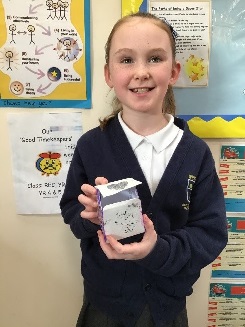
High-quality design and technology education makes an essential contribution to the creativity, culture, wealth and well-being of the nation and at Westleigh Methodist we endeavour to give every child the opportunity to be a part of this in their own unique way.
National Curriculum Objectives
Throughout each unit of work children will:
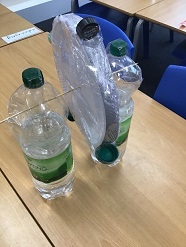
Key stage 1
Design
- Design purposeful, functional, appealing products for themselves and other users based on design criteria generate, develop, model and communicate their ideas through talking, drawing, templates, mock-ups and, where appropriate, information and communication technology
Make
- Select from and use a range of tools and equipment to perform practical tasks [for example, cutting, shaping, joining and finishing]
- Select from and use a wide range of materials and components, including construction materials, textiles and ingredients, according to their characteristics
Evaluate
- Explore and evaluate a range of existing products evaluate their ideas and products against design criteria
Technical knowledge
- Build structures, exploring how they can be made stronger, stiffer and more stable - explore and use mechanisms [for example, levers, sliders, wheels and axles], in their products
Key stage 2
Design
- Use research and develop design criteria to inform the design of innovative, functional, appealing products that are fit for purpose, aimed at particular individuals or groups - generate, develop, model and communicate their ideas through discussion, annotated sketches, cross-sectional and exploded diagrams, prototypes, pattern pieces and computer-aided design
Make
- Select from and use a wider range of tools and equipment to perform practical tasks [for example, cutting, shaping, joining and finishing], accurately
- Select from and use a wider range of materials and components, including construction materials, textiles and ingredients, according to their functional properties and aesthetic qualities
Evaluate
-Investigate and analyse a range of existing products
- Evaluate their ideas and products against their own design criteria and consider the views of others to improve their work
- Understand how key events and individuals in design and technology have helped shape the world
Technical knowledge
- Apply their understanding of how to strengthen, stiffen and reinforce more complex structures
- Understand and use mechanical systems in their products [for example, gears, pulleys, cams, levers and linkages]
- Understand and use electrical systems in their products [for example, series circuits incorporating switches, bulbs, buzzers and motors]
- Apply their understanding of computing to program, monitor and control their products.
Year 4
Materials - Making a Treasure Box
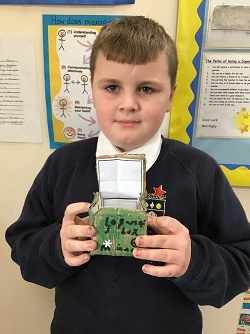
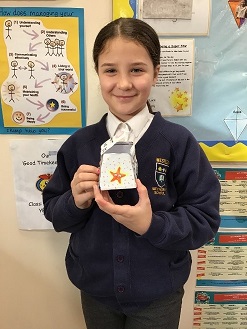
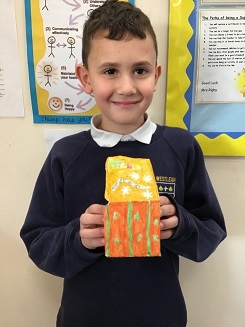
During this unit of work, Year 4 were asked to design a small box that they could use to keep their own special treasures in. They researched existing products and designs and gathered their favourite ideas. They selected the most appropriate materials and generated a plan to make the boxes. Each one was unique and special to each child.
Skills Used
- Cut materials accurately and safely using the correct tools
- Measure and mark to the nearest Millimetre
- Apply appropriate cutting and shaping techniques
- Select appropriate joining techniques
Mechanics -Moving Monsters
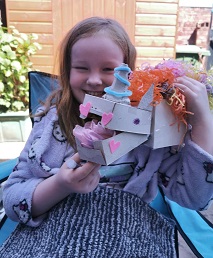
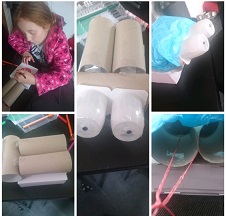
In this unit of work, children were asked to use pneumatic power or levers to make a moving monster. Their challenge was to use only things they could find from around their home. They watched videos of existing products and used these to generate ideas for their own products. Children really uxed their imaginations well in this unit to create a wide range of monsters that moved using a variety of mechanisms.
Skills Used
- Use scientific knowledge of the transference of force to choose appropriate mechanisms for a product (such as levers, winding mechanisms, pulleys and gears)
Year 5
Construction using inspiration from design through history - Water Wheels
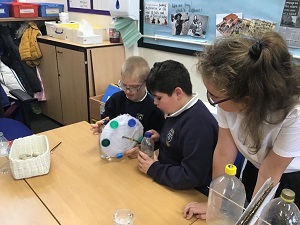
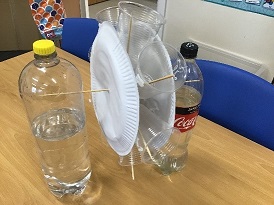
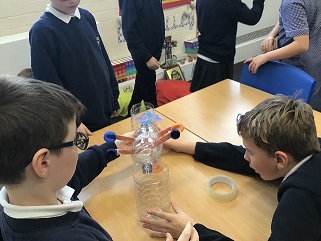
During this unit of work, Year 5 explored the use of water powered wheels to power cotton mills during the industrial revolution. They learned all about a local engineer named Richard Arkwright. They discovered that he was born in Preston and pioneered the idea for the first ever water wheel. This was so successful that variants of the wheel could be found all over the UK.
Skills Used
- Develop a range of practical skills to create a product (such as cutting, drilling and screwing, nailing, gluing, filing and sanding)
- Combine of design from a range of inspirational designers throughout history
Year 6
Construction using inspiration from design through history - Bridges
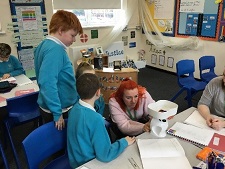
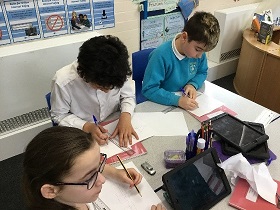
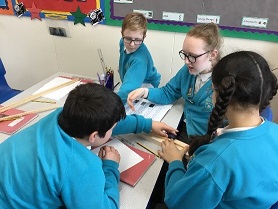
During their topic about America, Year 6 researched different typs of bridges such as suspension bridges and arch bridges. They then looked in more detailed at some American bridges. They also considered the work of the innovative 19th century civil engineer, Isambard Kingdom Brunel. They gathered ideas of their own to create bridges that would support the weight of a given number of cars.
Skills used
- Develop a range of practical skills to create a product (such as cutting, drilling and screwing, nailing, gluing, filing and sanding)
- Combine of design from a range of inspirational designers throughout history
Please find below our Design Technology Curriculum Overview and Progression of Skills and Knowledge below:
